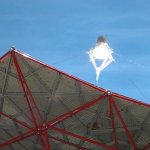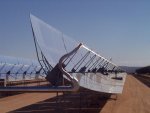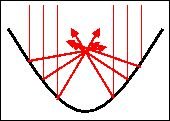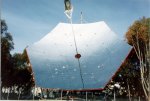 Solar thermal technology has been used on a domestic scale in Australia for some time, particularly for solar water heating. Internationally, solar thermal technology has been developed and is being applied to large scale electricity generation in countries such as Spain, the USA and even South Africa. Solar thermal technology has been used on a domestic scale in Australia for some time, particularly for solar water heating. Internationally, solar thermal technology has been developed and is being applied to large scale electricity generation in countries such as Spain, the USA and even South Africa.
Albeit slow to progress, Australia is beginning to realise
that, given the right circumstances, solar thermal energy
can even be cost competitive with coal fired generation.
The solar thermal system being tested at the Liddell Power Station in New South Wales is clear evidence to this.
Answers to some frequently asked questions about solar thermal energy can be found below. This includes questions such as:
What is it?
A “Solar Thermal” process is where solar energy is converted to heat. Solar thermal processes are generally classified into two categories: Low Temperature (LT) and High Temperature (HT). Low temperature generally involves the use of direct sunlight for heating water, which is then used for hot water, or to heat buildings or pools. These systems are widely deployed on the roofs of houses in the Northern Territory. Due to the need for higher efficiencies, solar thermal electricity generation usually employs a high temperature process.
back to top
How can it be used?
HT solar thermal involves the use of certain mirror configurations to concentrate and focus the sun’s energy into high temperature heat. This heat energy is then used to heat a working fluid (water/steam, molten salt, oil or organic fluids) that drives heat engines, which include steam turbines and Stirling engines. These heat engines output mechanical power, which can be used directly for purposes such as water pumping and grain grinding, or converted into electrical energy by a generator.
back to top
Where can it be used?
The optimal location for a solar thermal field is one with maximum direct sunlight, as these systems don’t run as well on cloudy days. Because heat is being harvested, these systems are ideal for use in deserts and arid areas, where it is always hot and sunny with little or no cloud. To find out if an area is suitable, it should be assessed to ascertain the quantity and quality of direct solar radiation it receives annually.
back to top
Why use Solar Thermal Power?
olar thermal is the most efficient form of solar energy harvesting on the market today (RISE). Other advantages include:
- Renewable
- Minimal environmental impact
- Minimal greenhouse gas emissions
- Ideal for large scale electricity generation
- Tax credits and rebate schemes can reduce capital costs
One of the disadvantages of solar thermal is that it can’t operate at night and so these systems are usually hybridised with gas or coal fired steam turbines, which are generally less efficient than un-hybridised systems. Another alternative is to have a plant that only runs at less than half capacity, and stores energy generated in the day to use at night. This energy is stored as heat energy, i.e. the medium (oil, salt etc.) is heated then stored in large thermally shielded tanks.
Other disadvantages are:
- Intermittent sunshine causes intermittent generation
- Not fully commercialised yet (higher cost, some technology risk)
- Best location usually remote, away from grid and users
- Large land coverage
back to top
How does it work?
 Solar thermal energy systems generate the high temperatures required by using mirrors to focus the incident sunlight onto thermal ‘receivers’. The thermal receivers then carry the thermal energy away using a fluid medium. The thermal energy can then be used to drive or assist electricity generation machinery such as combined cycle steam engines. The hot thermal fluid can also be stored so that its energy can be extracted at a later time. Solar thermal energy systems generate the high temperatures required by using mirrors to focus the incident sunlight onto thermal ‘receivers’. The thermal receivers then carry the thermal energy away using a fluid medium. The thermal energy can then be used to drive or assist electricity generation machinery such as combined cycle steam engines. The hot thermal fluid can also be stored so that its energy can be extracted at a later time.
There are three dominant types of mirror configurations used, parabolic troughs, power towers and parabolic dishes.
 The parabolic trough type of mirror collects and focuses the suns’ heat energy. This results in high temperature heat focused on a single point, as seen below. The parabolic trough type of mirror collects and focuses the suns’ heat energy. This results in high temperature heat focused on a single point, as seen below.
A receiver pipe runs along the focal point of all the parabolic mirrors. The heat energy is transferred to oil or another medium that is flowing through the pipes and is then pumped away to a heat exchanger that converts the heat to pressure (steam). This pressure is then used to drive a steam turbine generator.
The mirrors in a parabolic trough are arranged in north-south parallel rows and thus can track the sun throughout the day. Although these systems rely on sunlight, storage of the hot heat transfer fluid can allow electricity generation for several hours after dark.
As of late 2006, the world’s largest solar power plant is under construction in the Nevada desert near Las Vegas. It will have a capacity of 64MW.
 A Power Tower is simply a tall tower with a receiver on top. A heat transfer fluid flows through the receiver and absorbs the heat. A field of sun tracking mirrors that focus the sunlight onto the receiver surrounds the tower. These mirrors are known as heliostats. The first power tower used water directly, though it was retrofitted to utilise molten nitrate salt and an associated salt storage system. This can provide 24-7 power in sunny conditions. It should be noted that this is still an emerging technology. There is one large-scale tower in existence, which was used for testing purposes and is no longer operational. This tower is situated in Barstow, CA and is rated at 10MW. Two solar tower projects are under construction in Spain, having 10MW and 15MW capacity. A Power Tower is simply a tall tower with a receiver on top. A heat transfer fluid flows through the receiver and absorbs the heat. A field of sun tracking mirrors that focus the sunlight onto the receiver surrounds the tower. These mirrors are known as heliostats. The first power tower used water directly, though it was retrofitted to utilise molten nitrate salt and an associated salt storage system. This can provide 24-7 power in sunny conditions. It should be noted that this is still an emerging technology. There is one large-scale tower in existence, which was used for testing purposes and is no longer operational. This tower is situated in Barstow, CA and is rated at 10MW. Two solar tower projects are under construction in Spain, having 10MW and 15MW capacity.
 The final configuration is known as the parabolic dish. Like the parabolic trough the mirrors focus heat and light to a single point, at which is placed a heat receiver. Unlike the parabolic troughs this heat is then applied to an engine. The most common type of engine is the Stirling engine, which uses the heat directly to move pistons and create mechanical power and generate electricity. This Wikipedia article describes how Stirling engines work. The final configuration is known as the parabolic dish. Like the parabolic trough the mirrors focus heat and light to a single point, at which is placed a heat receiver. Unlike the parabolic troughs this heat is then applied to an engine. The most common type of engine is the Stirling engine, which uses the heat directly to move pistons and create mechanical power and generate electricity. This Wikipedia article describes how Stirling engines work.
Unlike Parabolic Trough and Power Tower systems, parabolic dish systems come in small to medium power ranges (9-40kW). This means they are suitable for distributed generation and remote power applications. They can also be grid connected. These systems are relatively easy to construct and are very efficient. It is important to note that they are still in development and some suffer from issues relating to the working fluid.
 Australian Researchers at the Australian National University developed an extra large version of a dish system, dubbed the “Big Dish”. It is intended to produce steam directly at the focus of the dish and by linking several of the dishes in parallel, they can power a steam turbine. This dish has a diameter of 25m and stands as tall as a five or six story building. It concentrates rays of light so accurately, that a dish was sold to Israel for astronomy and concentrating PV work. Australian Researchers at the Australian National University developed an extra large version of a dish system, dubbed the “Big Dish”. It is intended to produce steam directly at the focus of the dish and by linking several of the dishes in parallel, they can power a steam turbine. This dish has a diameter of 25m and stands as tall as a five or six story building. It concentrates rays of light so accurately, that a dish was sold to Israel for astronomy and concentrating PV work.
back to top
How can Novolta help?
Information on how we can help is located under the Services area of our website.
Further Information
Further information on solar thermal power can be found through the Research Institute for Sustainable Energy or this Wikipedia article or from the SolarPACES.
back to top
|
|

